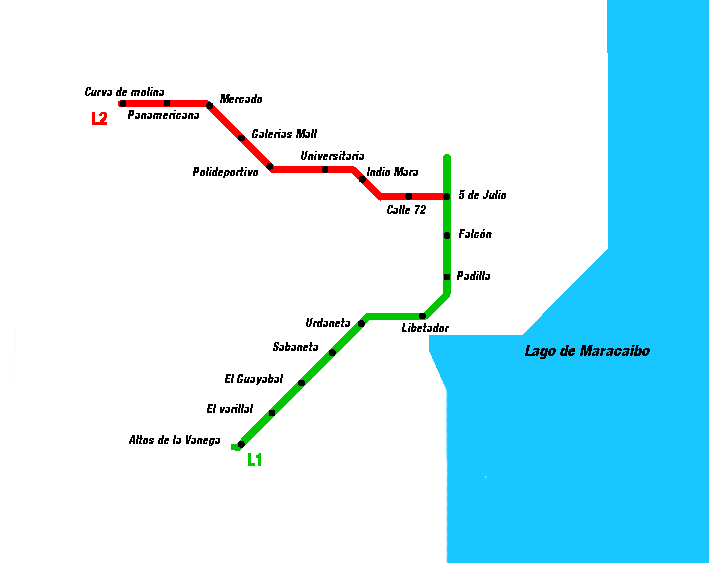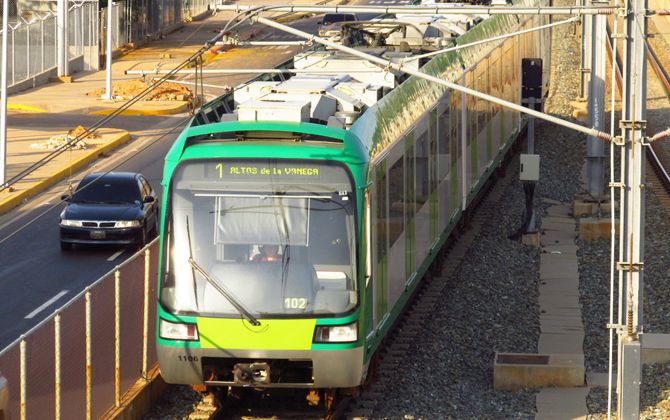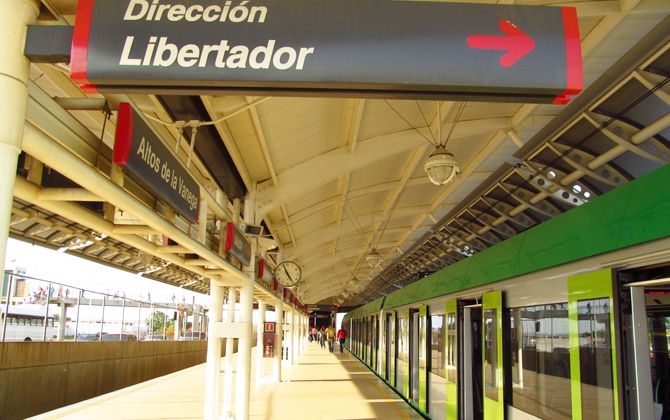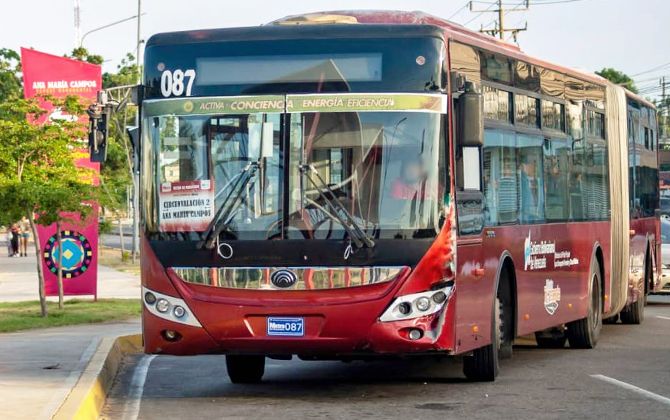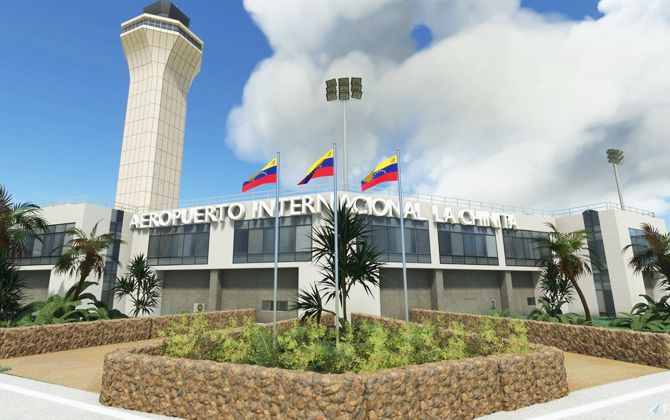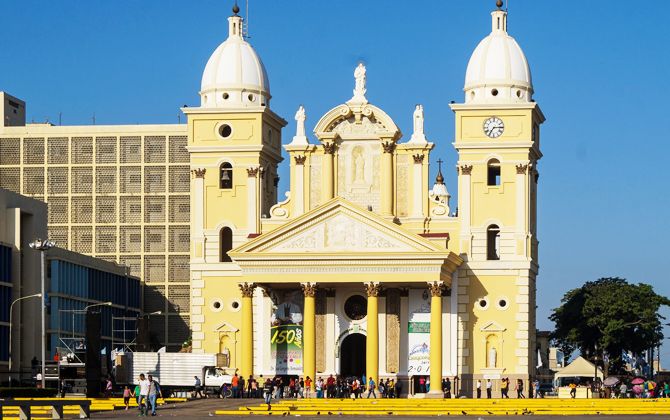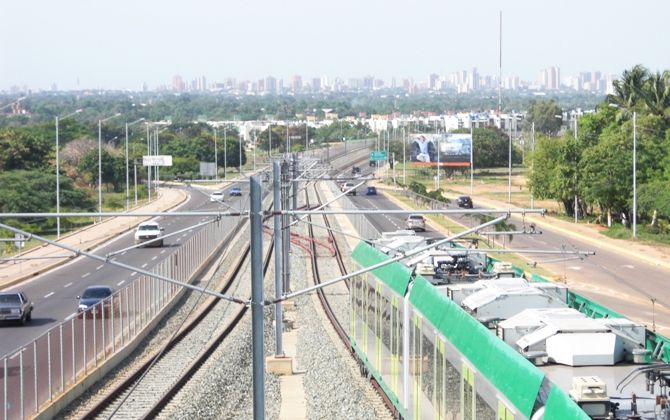The Maracaibo Metro, also known as Metro del Sol Amado, is a light rail system serving Maracaibo, the second-largest city in Venezuela. It opened between 2006 and 2009 and now operates a single line with six stations along a route of 6.5–8 km (4–5 miles).
The metro was built to reduce heavy traffic in this oil-industry hub, often called “La Tierra del Sol Amada” (“The Land of the Beloved Sun”). It is run by the state-owned Metro de Maracaibo Company and connects with city bus services.
Though small, the Maracaibo Metro provides air-conditioned, safe, and reliable transport for tens of thousands of passengers every day.
Metro Map of Maracaibo
All stations are located along Avenida Sabaneta/Libertador and the old Airport Road, covering both residential areas and central Maracaibo. The line is entirely at-grade or elevated, with four surface stations and two elevated terminal stations. Trains are powered by overhead electric wires at 750 V DC.
Since only one line is active, navigation is simple. Stations are clearly marked, and trains provide announcements before each stop.
Map of Valencia Metro showing different lines. Click on the map to enlarge it or download the Maracaibo metro map in PDF format.
Lines and Stations
Line 1 (Operational)
Line 1 is the only line in service. It runs from Altos de La Vanega in the southwest to Libertador in downtown Maracaibo. The route is about 6.5 km (4.0 mi) long and follows Avenida Don Manuel Belloso (Airport Road) and Avenida Sabaneta before curving north to Avenida Libertador. Construction took place in stages between 2006 and 2009. The line uses standard gauge and light metro specifications.
The metro was originally planned to have four lines totaling about 60 km (37 mi). So far, only the first segment of Line 1 is complete, with six stations:
- Altos de La Vanega – Southwestern terminal on Airport Road. One of the first stations opened in November 2006 (full service began in 2009). It serves the Altos de La Vanega suburb and the nearby depot. The design honors Maracaibo’s first bridge over Lake Maracaibo.
- El Varillal – At-grade station on Airport Road in the El Varillal neighborhood. Opened in 2006 (operational in 2009). It connects nearby residential areas. Together with Altos de La Vanega, it formed the initial trial segment.
- El Guayabal – At-grade station finished in 2007 and opened in 2009. Located between El Guayabal and Lomas de la Misión neighborhoods, it serves local communities.
- Sabaneta – Station on Avenida Sabaneta. Opened in May 2008 (operational in 2009). It lies between Santa Clara and Padre de la Patria sectors. The station has a single island platform serving both directions. Its name comes from the main avenue it serves.
- Urdaneta – Elevated station on Avenida Sabaneta (Tan Trino sector). Opened in June 2009. It has three levels and hosts the “1st City Metro Exhibition,” a photo display celebrating Zulia’s culture.
- Libertador – Northeastern terminal and busiest station, opened in 2009. It has three floors for passenger services. Located on Avenida Libertador, it sits across from Mercado Las Playitas and near the historic center. It serves as the main hub and will connect to planned future lines.
Timetable & Operating Hours
The Maracaibo Metro runs daily, with weekday and weekend schedules:
- Monday to Friday: 6:00 am – 6:00 pm (06:00–18:00). Earlier services once ran until 8:00–9:00 pm, but current operations end at 6:00 pm.
- Saturdays, Sundays, and Holidays: 8:00 am – 6:00 pm (08:00–18:00).
Trains run every 5–10 minutes. During peak hours (weekday mornings 6–9 am and afternoons), intervals can be as short as 5 minutes. Off-peak waits are around 8–10 minutes. A full trip along Line 1 takes 15–20 minutes, covering about 6–8 km (4–5 mi) at an average speed of 35 km/h (22 mph).
First and Last Trains
The first train leaves the terminal stations at opening time (around 6:00 am on weekdays, 8:00 am on weekends). The last trains depart near closing time at 6:00 pm. For example, the last departure from Libertador toward Altos de La Vanega is around 6:00 pm. Entrances close shortly after, so passengers should arrive a bit early for final rides.
Prices, Tickets and Cards
The Maracaibo Metro is heavily subsidized, making it one of the cheapest metro systems in the world. As of 2026, a standard one-way fare is VES 15 (15 bolívares), about $0.15 USD. The flat fare applies to any trip since there is only one line and a single fare zone.
Discounts and Free Rides
By national policy, seniors (women over 55, men over 60) and people with disabilities travel free with valid ID. Students receive a 50% discount, paying about VES 7.5–8 (≈$0.08 USD) per trip. Student discounts require a student ID or a special transit card. These concessions are valid on both metro and public buses.
Ticketing System
The metro uses rechargeable contactless smartcards. There are no paper tickets. Early systems used “T-Ticket” cards; today the nationwide SUVE (Sistema Único de Venta Electrónica) platform is integrated for digital fare payment.
- Purchasing a card: Cards are sold at stations and authorized outlets. A new card costs about VES 20–25 (≈$0.50 USD). Promotional bundles may include free rides.
- Adding balance: Cards can be recharged at station kiosks, cash desks, or online portals. Multi-ride packages are sometimes offered, such as 30 rides at a reduced rate.
- Using the card: Tap your card at the entry gate; the fare is deducted instantly. The same card works on MetroMara feeder buses for seamless transfers.
Connections
MetroMara Buses
MetroMara buses extend the metro’s reach to areas not served by rail. The network includes four main systems: the urban Bus Metromara and three suburban lines (Bus Urdaneta, Bus La Concepción, and Bus TransGuajira). Major metro stations—Libertador, Urdaneta, Sabaneta, El Varillal, and Altos de La Vanega—act as transfer hubs. From downtown Libertador, buses run along key avenues like La Limpia, Bella Vista, and 5 de Julio, connecting to commercial areas and the Simón Bolívar intercity terminal. At the southwestern end, Altos de La Vanega and El Varillal dispatch buses into outer neighborhoods. Buses run until early evening and are fully integrated with metro fare cards.
TransMaracaibo (Bus Rapid Transit)
TransMaracaibo is a BRT system of articulated buses on dedicated lanes. It connects areas outside the metro corridor, including routes into the Guajira region. While it uses separate stations, payment is integrated with the same card. Some routes start from metro hubs like Libertador.
Taxis and Por Puesto
Taxi stands and por puesto (shared taxis) operate near major stations, especially Libertador. They provide last-mile connections to areas beyond the metro. Fares are negotiated in bolívares or dollars. They are not part of the metro system but are widely used.
Access to the Airport
La Chinita International Airport (MAR) is not directly served by the metro. To get there, you’ll need a metro ride plus a feeder bus. The airport lies about 10 km (6 mi) southwest of the city center.
Metro + Metrobús Route
The MetroMara system operates Route 17, a dedicated Airport bus linking Altos de La Vanega station with La Chinita Airport. The route has three stops: Altos de La Vanega station, BAU (Base Aérea Rafael Urdaneta), and the airport terminal.
The airport bus runs on a limited schedule, usually during weekday peak hours. For example, one timetable had buses from 7:15–9:15 am and 4:00–6:00 pm, Monday through Friday. Outside these times and on weekends, service may be irregular.
The bus takes about 15–20 minutes from Altos de La Vanega to the airport, depending on traffic. From downtown, the total trip via metro plus bus usually takes 35–45 minutes.
Alternatives
If the airport bus isn’t running, taxis or ride-hailing services are the best option. The trip from central Maracaibo takes 20–30 minutes and costs about $10–15 USD. Budget travelers may also use local buses or shared taxis heading toward San Francisco or “Kilómetro 4,” then transfer to a short taxi ride, but this is only recommended for those familiar with local transport.
Tips and Rules
- Follow Metro Norms. Rules are posted at all stations: no smoking, eating, or drinking; no littering; no dangerous goods. Give up seats to seniors, pregnant women, or people with disabilities. Loud music is not allowed; use headphones.
- Security and Safety. Stations and trains are monitored by cameras and security staff, often supported by the National Guard. Keep an eye on belongings, stand behind the yellow line on platforms, and follow exit signs. For help, contact station staff or OPA (User Assistance Operators).
- Train Etiquette. Let passengers exit before boarding. Inside, move to the center and keep doorways clear. Hold onto poles or handrails, as trains accelerate quickly. Air-conditioning can be strong, so a light jacket may be useful.
- Peak Hour Strategies. Crowds are heaviest weekdays 7–9 am and 4–6 pm. If possible, travel outside those hours. On weekends, trains are less crowded but service ends at 6:00 pm.
- Cleanliness and Comfort. Stations and trains are kept clean. Some terminals (like Libertador) have restrooms. Trash bins are available, and free Wi-Fi is offered under the “MetroMara WiFi” network.
- Language. Announcements are in Spanish. Station names match nearby neighborhoods. Some staff may know basic English, but it’s helpful to carry your destination written down.
History
The Maracaibo Metro grew out of the city’s rapid expansion and need for mass transit.
1990s – Conception: A 1983 Presidential Transport Commission recommended rapid transit to ease congestion. The operating company, Metro de Maracaibo, C.A., was founded on July 20, 1993. Initial shareholders were the City of Maracaibo (60%) and Zulia State (40%).
Early 2000s – Construction begins: The first stone of Line 1 was laid in 2003. The national government later took a 67% majority stake, unlocking federal support.
2006 – First trains and soft opening: The first train arrived from Germany in July 2006 and was displayed publicly to build support. On November 25, 2006, two stations—Altos de La Vanega and El Varillal—opened in trial service with free rides.
2007–2008 – Service expands: El Guayabal opened on August 27, 2007; Sabaneta on May 11, 2008. Service remained limited and fares were not yet collected. Trains initially passed Urdaneta while it was completed.
June 2009 – Full Line 1 in service: On June 8, 2009, full commercial operations began from Altos de La Vanega to Libertador, all six initial stations open.
2010s – Plans and setbacks: A second phase of Line 1 and a new Line 2 were announced, but hyperinflation and budget cuts slowed or halted works. Visible progress on new stations was minimal by the late 2010s.
2020s – Recent developments: In 2023 the metro overhauled AC units, replaced power cables, rolled out the T-Ticket digital system, and added Wi-Fi at all six stations. In June 2026, after repairing a fifth trainset, full service resumed on the regular schedule.
Historical significance: Maracaibo is Venezuela’s second metro (after Caracas, 1983) and one of three nationwide (with Valencia). Investment reached about $495 million USD by 2006 and was later estimated near $1 billion USD, prompting controversy and a 2009 investigation into the 1998 Siemens contract. Despite headwinds, the system remains a local point of pride.
Nearby Attractions
- Historic Downtown Maracaibo: From Libertador station, the historic center is a short walk or taxi ride. Highlights include Plaza Bolívar, Maracaibo Cathedral, Casa de la Capitulación, and Teatro Baralt (1883). Calle Carabobo offers colorful colonial facades and artisan shops.
- Basílica de Nuestra Señora de Chiquinquirá (La Chinita): Maracaibo’s main basilica sits in El Saladillo, about 2–3 km (1.2–1.9 mi) north of Libertador. Reach it by short taxi or buseta. Each November, the Feria de la Chinita festival centers here.
- Mercado Las Playitas: Right by Libertador station. A lively market (Las Pulgas) for produce, snacks, and electronics. Keep belongings secure in the crowds.
- Vereda del Lago Park: Lakefront park with trails and playgrounds. From Libertador, it’s roughly 5 km (3.1 mi) by taxi or bus. Views of the Rafael Urdaneta Bridge are best around dawn or late afternoon.
- General Rafael Urdaneta Bridge: An 8.7 km (5.4 mi) concrete span over Lake Maracaibo, opened in 1962. Not served by metro, but visible from Vereda del Lago and other vantage points. The bridge inspired station architecture and murals.
- MACZUL (Contemporary Art Museum): Near Universidad del Zulia, about 8 km (5.0 mi) from Libertador. Go by car or bus. Check hours before visiting.
- Sambil Maracaibo Mall: Large shopping mall northwest of downtown. Not on the metro; take a feeder bus or taxi from Libertador. Good for cooling off and shopping.
- Zulia Botanical Garden: A quiet green space with regional flora in the eastern city. Access via feeder bus from Libertador/Urdaneta or by taxi.
- Santa Lucía & Calle Carabobo: A charming neighborhood of bright colonial houses, cafés, and evening gaita music in season. A short ride from Libertador.
- Base Aérea Museum (Aeronautical): Near the BAU stop on the airport bus route. Entry may require prior permission; of interest to aviation fans.
- Other highlights: Beyond metro reach, consider Laguna de Sinamaica and the La Guajira region (guided trips). Within the city: Children’s Museum (Museo Planetario) and Luis Aparicio “El Grande” Stadium. Taxis from Sabaneta or Urdaneta are the practical option for games.
Fun Facts
“Metro del Sol Amado”: Locals use this nickname—“Metro of the Beloved Sun”—a nod to Maracaibo’s epithet, “La Ciudad del Sol Amado.” The branding includes sun motifs and feeds civic pride.
Bridge-inspired design: Station architecture echoes the General Rafael Urdaneta Bridge. Altos de La Vanega references the first lake bridge with truss-like forms. The goal: tie the metro to local heritage.
Ingenuity under sanctions: In 2026, engineers rebuilt a transformer and rewired a pantograph using local parts, returning Train #5 to service. It showcased homegrown problem-solving.
Keeping the lights on: After the March 2019 national blackout, the metro strengthened contingency plans and worked with Corpoelec on a dedicated feed. A traction substation added in 2023 improved reliability.
System records (local): Maracaibo was Venezuela’s third metro after Caracas and Valencia. Line 1 (6.5 km / 4.0 mi) was slightly longer than Valencia’s initial line (~6.2 km / 3.9 mi). With Padilla, Falcón, and 5 de Julio, Line 1 would reach ~9 km (~5.6 mi) and nine stations.
Culture and language: Campaigns use Zulian phrases like “¡Que molleja e’ fácil!” to promote easy travel with digital cards—mixing service info with local humor.
Weather resilience: AC is essential in 35 °C (95 °F)+ heat. Storms and lightning are common; grounding and lightning protection are in place. In 2023, storm damage to catenary was repaired.
Station mini-museum: Urdaneta hosts the “First City Metro Exhibition,” a small photo display on Zulia’s culture and history.
Future Extensions
The master plan envisions four lines (≈60 km / ≈37 mi) across Maracaibo. Progress has been slow, but the blueprint remains.
- Line 1 – Second stage: Extend north from Libertador with three stations: Padilla, Falcón, and 5 de Julio. Line 1 would grow to nine stations and ~9 km (~5.6 mi). 5 de Julio is planned as an interchange with Line 2. Preparatory works were started years ago; construction is not active as of 2026.
- Line 2 – Westward: Starts at 5 de Julio (transfer to Line 1) and heads toward the west/northwest (Paraíso, Indio Mara) to La Curva de Molina. Initial phase considered five underground stations (Padilla, Falcón, 5 de Julio, Calle 72, Indio Mara) across both lines. Full Line 2 would be ~8.5 km (~5.3 mi) with ~9–10 stations, serving dense districts and the LUZ area. Work has been paused due to funding; completion date unknown.
- Line 3 – South–northeast spine: From La Coromoto (south, San Francisco municipality) to La Virginia (northeast). About 19 km (~11.8 mi) and 25 stations, intersecting Lines 1–2. Still at the planning stage.
- Line 4 – Northern crosstown: East–west across the city’s north, from Sector Cujicito to Sector El Silencio. About 17 km (~10.6 mi) and 21 stations, interfacing with Lines 2–3. Planning stage only.
Current outlook (2026): Economic constraints paused tunneling and station works. Officials have periodically signaled interest in reactivating projects. A realistic first step would be completing Padilla–5 de Julio to boost ridership in the core, then advancing Line 2 westward in sections. Alternative interim ideas (e.g., tram/light rail) have been floated but the metro plan remains primary.
